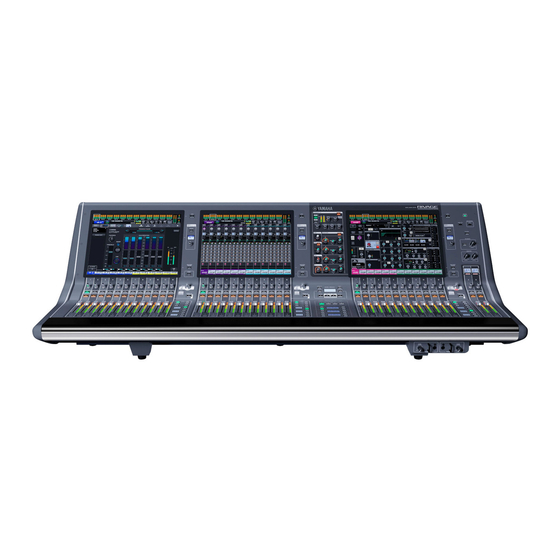
Table of Contents
Advertisement
Advertisement
Table of Contents

Summarization of Contents
Safety and Precautions
Graphical Symbols and Warnings
Explanation of graphical symbols used for safety warnings and cautions in the manual.
Regulatory and Disposal Information
FCC, Compliance, and Disposal
Information regarding FCC compliance, supplier's declaration, and disposal of old equipment.
General Precautions
Electrical and Physical Safety Measures
Covers precautions for electrical shock, fire hazards, and physical injury during use.
Document Information
Manuals, Software, and Copyrights
Details on related manuals, software, and copyright information.
Introduction
About the Manuals
Overview of the CS-R5 Owner's Manual and related RIVAGE PM series manuals.
Utility Software and Accessories
Software, Firmware, Conventions, and Accessories
Information on utility software, firmware updates, manual conventions, and included accessories.
Hardware Overview: Top Panel
Part Names and Functions
Identification and description of the CS-R5 top panel components and their functions.
Selected Channel Controls
Dynamics Processing
Detailed explanation of the Dynamics 1/2 section and its setting knobs.
Channel Signal Processing
Gain, EQ, and Other Controls
Description of Gain, HPF, PAN, Fn, and Equalizer controls on the selected channel.
Utility Section Functions
Ports, System, Talkback, and Monitor Controls
Explanation of USB ports, system functions, talkback, and monitor controls in the utility section.
Scene Memory Operations
Overlay, Undo, Store, and Recall
Procedures for using Overlay, Undo, Store, and Recall functions for scene memory.
User Defined Keys
Bank Selection and Key Assignment
Details on selecting user-defined key banks and assigning functions.
Touch Screen Interface
Basic Operation and Controls
Introduction to the touch screen, its operation, and basic controls like VIEW and SEND/KNOB.
Channel Strip Controls
Encoders, Shift, and Fader Modes
Explanation of encoder assignment, shift key usage, and sends on fader mode.
Channel Strip Details
Strip Encoders and Status Indicators
Details on strip encoders, selection keys, channel status, and meter LEDs.
Channel Layer and I/O Selection
Layer and Input/Output Key Functions
Explanation of layer selection keys and input/output key functions for routing.
Front Panel Features
Headphone Controls
Description of PHONES A/B level knobs and output jacks on the front panel.
Rear Panel Connectivity
Ports, Controls, and Audio Jacks
Details on rear panel connectors like LAMP, MIDI, GPI, OMNI, and AES/EBU.
Power Supply and Shutdown
Connecting and Shutting Down
Procedure for connecting power sources and safely shutting down the unit.
Installing and Removing Optional Cards
Mini-YGDAI Card Procedures
Instructions for installing and removing Mini-YGDAI I/O cards.
Touch Screen Operations
Basic Interactions and UI Components
Explains basic touch screen operations, tabs, buttons, and fader/knob interactions.
Other Operations
Initialization and Fader Calibration
Procedures for initializing the unit to factory defaults and calibrating motorized faders.
Specifications
General and Audio Specifications
Technical specifications including mixing capacity, sampling frequency, and audio performance.
Performance Specifications
Dynamic Range, Crosstalk, and I/O
Details on dynamic range, crosstalk, input/output characteristics, and digital I/O.
Connectivity Specifications
I/O Slots and Pin Assignments
Specifications for I/O slots, control I/O, and pin assignment tables.
















Need help?
Do you have a question about the CS-R5 and is the answer not in the manual?
Questions and answers